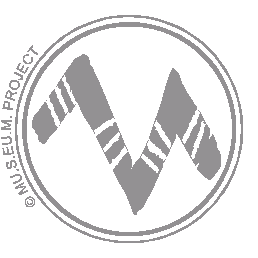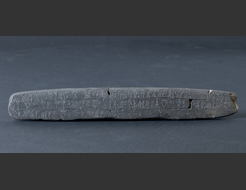|
||||||||||||||||||||||||||||||||
|
|
Museum of: Athens | |||||||||||||||||||||||||||||||
| Name of the artefact: Linear B Tablet | ||||||||||||||||||||||||||||||||
|
Clay tablet with Linear B ideograms, the text of which,
in three rows, refers to cooking vessels. |
||||||||||||||||||||||||||||||||
|
WHERE IS IT AND MAIN
CHARACTERISTICS |
STATE |
|||||||||||||||||||||||||||||||
|
Department: |
Prehistoric |
Preservation: |
Very good | |||||||||||||||||||||||||||||
|
Inventory number: |
Ta 709-712 |
Restauration: |
Restored | |||||||||||||||||||||||||||||
|
Name of the artefact: |
Linear B Tablet |
Completeness: |
Complete | |||||||||||||||||||||||||||||
|
Object type: |
Other |
|||||||||||||||||||||||||||||||
|
Material: |
Clay |
|||||||||||||||||||||||||||||||
|
Methof of manufacture: |
Hand made |
|||||||||||||||||||||||||||||||
|
Decoration
type: |
No decoration |
|||||||||||||||||||||||||||||||
|
Distinctive mark: |
Script |
|||||||||||||||||||||||||||||||
|
DIMENSIONS |
PERIOD OF USE |
|||||||||||||||||||||||||||||||
|
Length (mm): |
265 |
Epoque: |
Bronge Age |
|||||||||||||||||||||||||||||
|
Heigth
(mm): |
- |
Culture: |
Mycenaean |
|||||||||||||||||||||||||||||
|
Diameter
(mm): |
- |
Period: |
Late Helladic |
|||||||||||||||||||||||||||||
|
Width (mm): |
38 |
Face: |
LH III B |
|||||||||||||||||||||||||||||
|
Thickness (mm): |
14 |
Absolute chronology: |
13 century BC |
|||||||||||||||||||||||||||||
|
Weight
(g): |
- |
|||||||||||||||||||||||||||||||
DISCOVERY |
||||||||||||||||||||||||||||||||
|
Date: |
- |
Country: |
Greece |
|||||||||||||||||||||||||||||
|
District: |
Peloponnese |
Town hall affiliation: |
Kalamata |
|||||||||||||||||||||||||||||
|
Village: |
Pylos |
Discovery findspot: |
Mycenaean Palace |
|||||||||||||||||||||||||||||
|
Condition of discovery: |
Archaeological excavation |
Discovery type: |
Deposit |
|||||||||||||||||||||||||||||
|
ANALYSES – DETERMINATIONS |
FILLED IN BY |
|||||||||||||||||||||||||||||||
|
Type: |
- |
Name: |
Eleni Papazoglou-Manioudaki |
|||||||||||||||||||||||||||||
|
Laboratory: |
- |
Institution: |
National Archaeological Museum -
Greece |
|||||||||||||||||||||||||||||
|
No./Code: |
- |
Date: |
21/11/2005 |
|||||||||||||||||||||||||||||
|
DEEPENINGS |
||||||||||||||||||||||||||||||||
|
Morphology of the object: |
||||||||||||||||||||||||||||||||
|
The texts were inscribed on damp clay tablets,
rectangular or elongated in shape, using a sharp bone or bronze stylus.
The tablet was left to dry in the sun and then stored in the palace
archives, arranged by subject inside baskets. When the mycenaean palaces
were destroyed by fire at the end of the 13th centuru BC the tablets were
baked and so preserved until today. The texts written on the tablets were
simple: lists of personnel, inventories of objects that were meant for the
palace or as offerings to the gods, tax forms. The Pylos tablet, presented
here, is elongated and inscribed on one of the flat surfaces. It was
reconstructed from three pieces. The different colours of the clay
originate from the fact that the tablet was broken and the pieces were
burnt in the fire, that destroyed the palace, under different conditions.
The inscription reads from left to right and the lines are separated by
horizontal incisions. The text makes use of syllabograms, ideograms and
numerical signs (photo). |
||||||||||||||||||||||||||||||||
|
Decoration: |
||||||||||||||||||||||||||||||||
|
- |
||||||||||||||||||||||||||||||||
|
Inscription: |
||||||||||||||||||||||||||||||||
|
Linear B is a syllabic script with approximately ninety
syllabic signs, ideograms aand numerals. It is an adaptation of the
earlier Minoan Linear A script (tablet photo) in use at the palace of
Knossos which was occupied by the Mycenaeans after 1450 BC. British
architect Michael Ventris, with the assistance of philologist professor
Jihn Chadwick deciphered Linear B in 1952. Linear B tablets are found at
Mycenae, Tiryns and Thebes in the Greek mainland, Knossos and Chania on
Crete. |
||||||||||||||||||||||||||||||||
|
Analogies: |
||||||||||||||||||||||||||||||||
|
This tablet comes from the great Mycenean archive found
in the palace of Nestor at Pylos |
||||||||||||||||||||||||||||||||
|
Interpretation: |
||||||||||||||||||||||||||||||||
|
The Linear B tablets are the first written documents in
the Greek language, five hundred years earlier than the Homeric poems.
They come from the archives that were kept at the Mycenaean palaces, which
were the the administrative, economical and religious centres of large
territories. They provide valuable information on the palace hierarchy,
the professional and social classes, the production and manufacture of
goods. |
||||||||||||||||||||||||||||||||
|
Bibliography: |
||||||||||||||||||||||||||||||||
|
- |
||||||||||||||||||||||||||||||||

